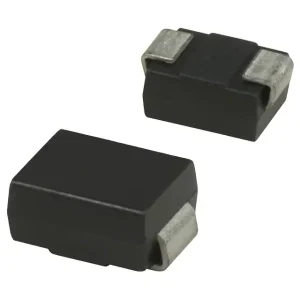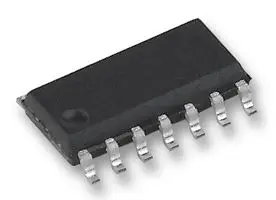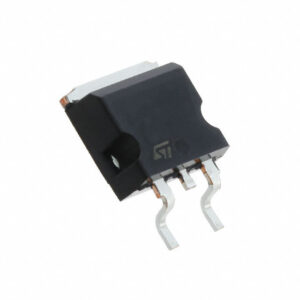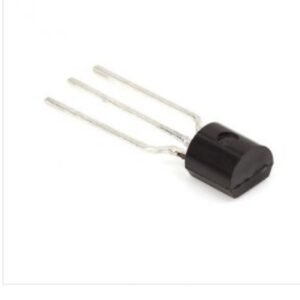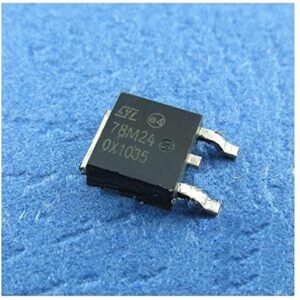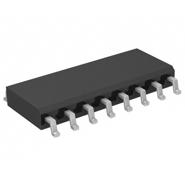STM32F030F4P6 TSOP
SKU:
STM32F030F4P6
Category: STMicroelectronics
Shipping & Delivery
Related products
74HC132ST SOIC
The M74HC132 is a high-speed CMOS quad 2-input Schmitt NAND gate fabricated with silicon gate C2MOS technology. Pin configuration and function are identical to those of the M74HC00. The hysteresis characteristics (around 20 % VCC) of all inputs allow slowly changing input signals to be transformed into sharply defined jitter-free output signals.
All inputs are equipped with protection circuits against static discharge and transient excess voltage.
Download Datasheet:
7805ST TO263
The L78 series of three-terminal positive regulators is available in TO-220, TO-220FP, D²PAK and DPAK packages and several fixed output voltages, making it useful in a wide range of applications.
These regulators can provide local on-card regulation, eliminating the distribution problems associated with single point regulation. Each type embeds internal current limiting, thermal shut-down and safe area protection, making it essentially indestructible. If adequate heat sinking is provided, they can deliver over 1 A output current. Although designed primarily as fixed voltage regulators, these devices can be used with external components to obtain adjustable voltage and currents.
78L05ST SOT89
The L78L series of three-terminal positive regulators employ internal current limiting and thermal shutdown, making them essentially indestructible. If adequate heat-sink is provided, they can deliver up to 100 mA output current. They are intended as fixed voltage regulators in a wide range of applications including local or on-card regulation for elimination of noise and distribution problems associated with single-point regulation. In addition, they can be used with power pass elements to make high-current voltage regulators. The L78L series used as Zener diode/resistor combination replacement, offers e improvement along with lower quiescent current and lower noise.
78M24ST DPAK
The L78M series of three-terminal positive regulators is available in TO-220, TO-220FP, DPAK and IPAK packages and with several fixed output voltages, making it useful in a wide range of applications. These regulators can provide local on-card regulation, eliminating the distribution problems associated with single point regulation. Each type employs internal current limiting, thermal shutdown and safe area protection, resulting it essentially indestructible. If adequate heat sinking is provided, they can deliver over 0.5 A output current. Although designed primarily as fixed voltage regulators, these devices can be used with external components to obtain adjustable voltage and currents.
CD4021ST SOIC
The HCF4021 is a monolithic integrated circuit fabricated in metal oxide semiconductor technology available in PDIP-16 and SO-16 packages.
This device is an 8-stage parallel or serial-input/serial-output register having common clock and parallel/serial control inputs, a single serial data input, and individual parallel "jam" inputs to each register stage. Each register stage is a D-type, master-slave flip-flop in addition to an output from stage 8. "Q" outputs are also available from stages 6 and 7. Serial entry is synchronous with the clock but parallel entry is asynchronous.
In this device, entry is controlled by the parallel/serial control input. When the parallel/serial control input is low, data are serially shifted into the 8-stage register synchronously with the positive transition of the clock line. When the parallel/serial control input is high, data are jammed into the 8-stage register via the parallel input lines and synchronous with the positive transition of the clock line. The clock input of the internal stage is “forced” when asynchronous parallel entry is made. Register expansion using multiple packages is permitted.
L6562ST SOIC8
The L6562A is a current-mode PFC controller operating in Transition Mode (TM). Coming with the same pin-out as its predecessors L6561 and L6562, it offers improved performance.
The highly linear multiplier includes a special circuit, able to reduce AC input current distortion, that allows wide-range-mains operation with an extremely low THD, even over a large load range.
The output voltage is controlled by means of a voltage-mode error amplifier and an accurate (1% @TJ = 25°C) internal voltage reference.
The device features extremely low consumption (60µA max. before start-up and <5 mA operating) and includes a disable function suitable for IC remote ON/OFF, which makes it easier to comply with energy saving requirements (Blue Angel, EnergyStar, Energy2000, etc.).
An effective two-step OVP enables to safely handle overvoltages either occurring at start-up or resulting from load disconnection.
The totem-pole output stage, capable of 600 mA source and 800 mA sink current, is suitable to drive high current MOSFETs or IGBTs. This, combined with the other features and the possibility to operate with the proprietary Fixed-Off-Time control, makes the device an excellent low-cost solution for EN61000-3-2 compliant SMPS in excess of 350W.



